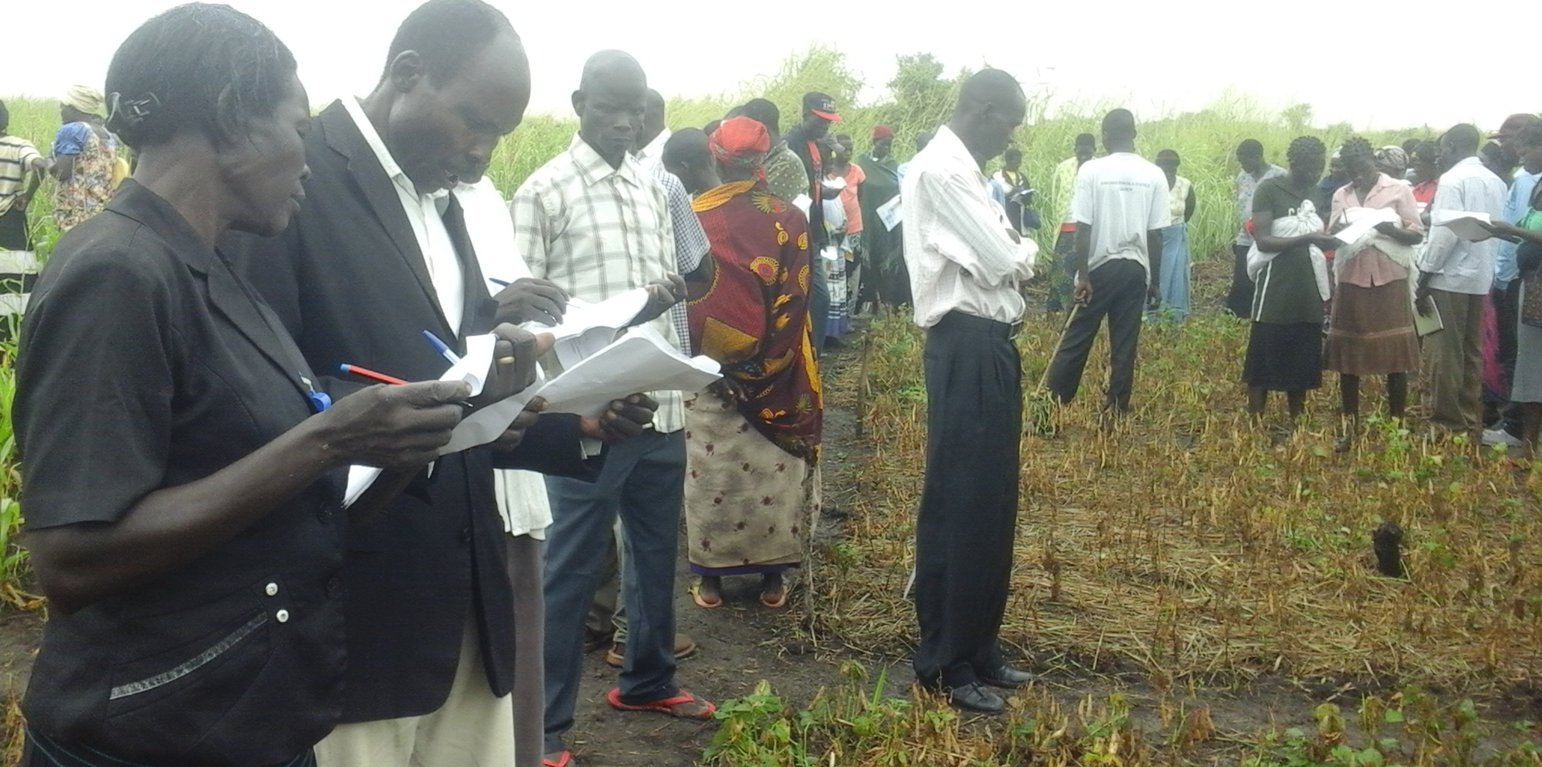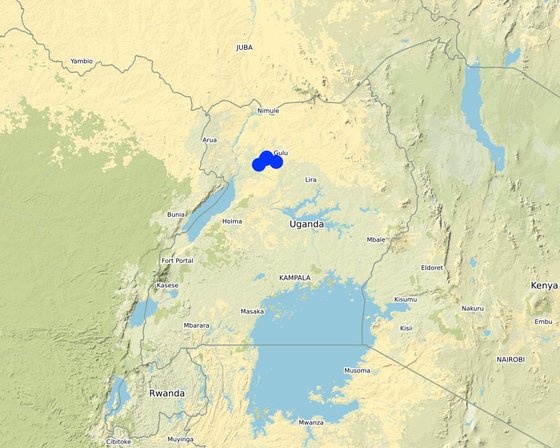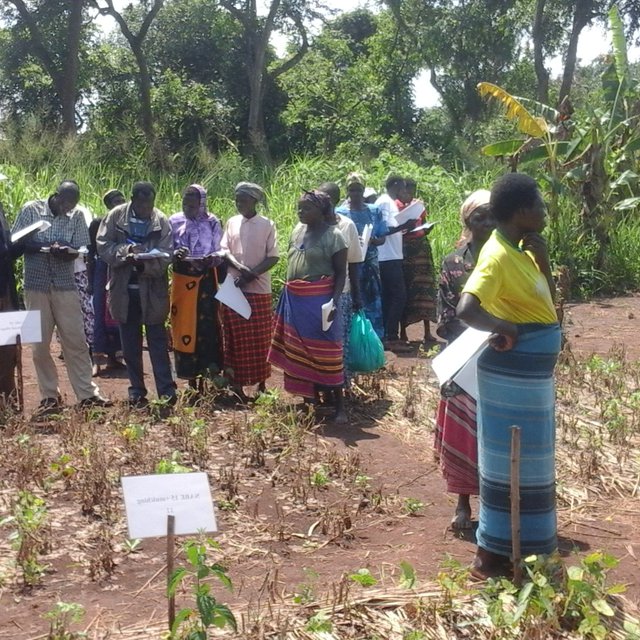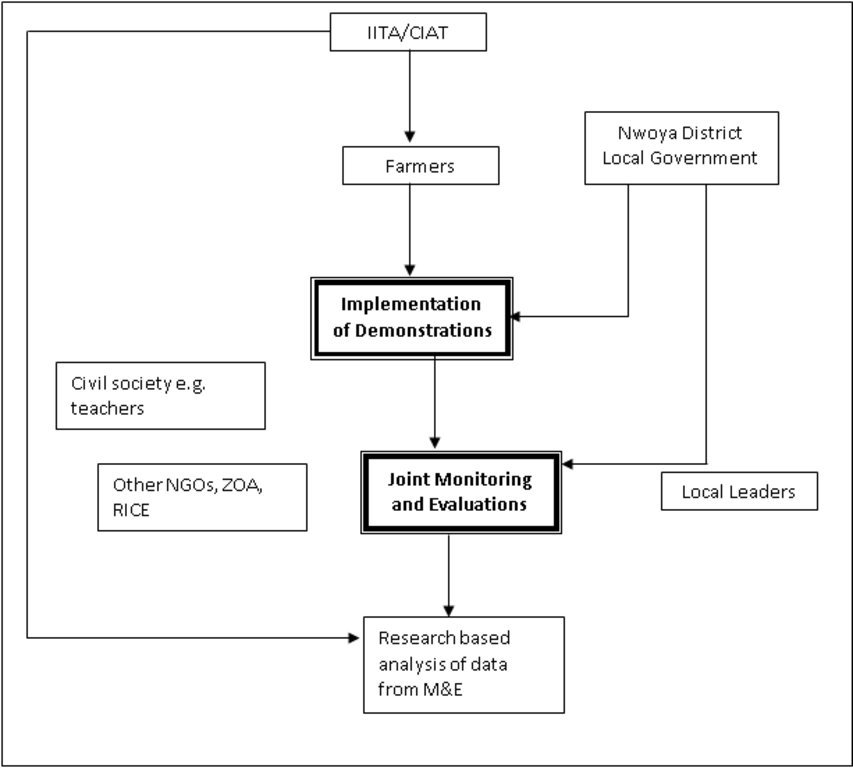



Demonstration plots established to train farmers are common channels through which recommended farming practice(s) are demonstrated to local farmers. During this process, all the relevant stakeholders in the agricultural sector, for example farmers, local leaders and government extension officers, partner organisations, and the lead implementing agency plan together on how best to implement the demonstration with emphasis on the host community, their roles and responsibilities so as to ensure successful implementation of the demonstration.
Stakeholders involved include:
•Group and community members (women, youth and men)
•Local leaders and authorities
•Civil servants
•Partner Non-Governmental Organisations (NGOs)
•Lead implementing agencies (International Institute of Tropical Agriculture, IITA and International Center for Tropical Agriculture, CIAT)
For the subsequent monitoring and evaluation (M&E) process, the participating stakeholders are invited for a field day on the site of the demonstration. Such M&E process is performed twice or three times during implementation of the demonstration activities depending on necessity, availability of time and resources. The M&E tool is designed by the M&E officer in the organization (IITA/CIAT) supported by the Field Officer/Research Assistant who is responsible for carrying out the field activities. The emphasis of the M&E process is on the goals and objectives, sustainability and adaptive nature, socio-economic and political environment, gender and policy considerations and impacts of the project being implemented. Group members help identifying the stakeholders in their community who can be resourceful in evaluating the demonstrations.
The Participatory Monitoring and Evaluation (PM&E) of the demonstration process, activities and performance is then carried out. It aims to:
•Assess the technology/practice(s) in question in terms of crop vigour and yield
•Understand the resilience of the practice to local prevailing climatic and weather conditions
•Assess whether equal opportunity was given for all community members to participate
•Assess the level of cooperation among group members during meetings
•Understand the gender perspectives with regard to gender equality, woman and youth involvement
•Test for the benefits, performance, pros and cons, and the opportunity cost involved in adopting a demonstrated technology
The PM&E questionnaire is based on IITA/CIAT PM&E tool and is composed of the following chapters:
1.Socio-demographic characteristics: district, sub-county, village, name, telephone contact, age, sex, educational level, employment and group-membership of the participant.
2.Farming characteristics: years of farming experience, total amount of land owned and allocated for farming or particular technology of interest, type of seed (local or improved) and the variety of the crop in question, source of seed and whether or not the participant participated in implementing the demonstration.
3.Implementation performance: Demo-plot location, distance, farmer trainings, demo-management, partnerships in the implementation, participation, cooperation, importance, relevance, monitoring of the demo, involvement in terms of community, gender, youth and the vulnerable groups and attendance.
4.Crop performance: Germination percentage, crop vigour, plant height, number of pods/cobs, pod/cob filling, maturity duration, yield, soil quality, pest occurrence, disease and drought resistance/tolerance.
5.Agro-ecological benefits: This can be ranked in terms of importance of the practice for soil fertility and bio-diversity, adaptation to weather variability and climate change.
6.Socio-economic benefits: This is ranked based on importance for household food and nutrition security, source of income, labour demands and cost of implementation.
7.Participants are then required to rank the technologies monitored.
The scale of ranking ranges from 1 to 5, where 1=Very Unhappy, 2=Unhappy, 3=neither Happy nor Unhappy, 4=Happy, 5=Very Happy. For certain questions, emoji illustrations are also used for the monitoring process.

Местоположение: Nwoya District, Northern Uganda, Уганда
Дата ввода в действие: н/п
Дата завершения: н/п
Тип Подхода
| Какие заинтересованные стороны/ организации-исполнители участвовали в реализации Подхода? | Перечислите заинтересованные стороны | Опишите роли заинтересованных сторон |
| местные землепользователи/ местные сообщества | Farmers | Establish the demonstration, carry out activities in demonstrations, monitor and evaluate the demonstration |
| организации местных сообществ | Local CBOs | Partipate in M&E of the demonstration |
| ученые-исследователи | International Institute of Tropical Agriculture (IITA), International Center for Tropical Agriculture (CIAT) | Introduced the monitoring / evaluation approach, participate in the monitoring process |
| учителя/ преподаватели/ школьники / студенты | Teachers from local schools | Participate in monitoring / evaluation |
| общественные организации | Organisation ZOA - from relief to recovery (https://www.zoa-international.com/), other local NGOs | Participate in monitorng / evaluation |
| местные власти | Subcounty and District officials | Participate in monitorng / evaluation |
Flow chart showing process that leads to the implementation of participatory monitoring and evaluation

Решения принимались
Принятие решений было основано на
IITA-Climate Smart Agriculture Research. Research focused on increasing food security and farming systems' resilience in East Africa
Refreshments during PM&E and demonstration activities eg. water or soft drinks
Local users understand what kind of paramenters can be considered for an evaluation
The approach enables farmers to take decisions based on what they observed during the evaluation process
All stakeholders took part in the implementation and PM&E process. This improved coordination and resource sharing
Stakeholder platform helps to share and identify potential sources of resource and fund mobilisation
Each participant understood in depth the process involved in implementing a given technology
Participants learned important indicators for demonstrations and how to assess them
Many stakeholders were part of the platform, ranging from local schools and institutions as part of the civil society
Participants learned how to collaborate in groups
All community members were invited to learn and participate hence acquiring knowledge
The approach involved all age groups and gender with focus on widows
Youth were at the forefront of implementation
Participants learned about the importance of learning and the allocation for various activities. ZOA carried out land and conflict resolutions and helped farmers acquiring land titles from the Government
Participants identify which technology addresses their food and nutrition security needs
Farmers identify which technology is a suitable income basing on the available market opportunities
The approach utilized local community group which also carry out Savings, borehole maintenance and community Village Health teams
Farmers identify technologies, resilient to weather variability and weather extremes
During the PM&E Process, the land users are required to indicate their interest in the adoption of particular technologies and the challenges they would face. Therefore this process enables the farmers to know the requirements for implementing a given technology, pros and cons and how to sustain it economically and environmentally.